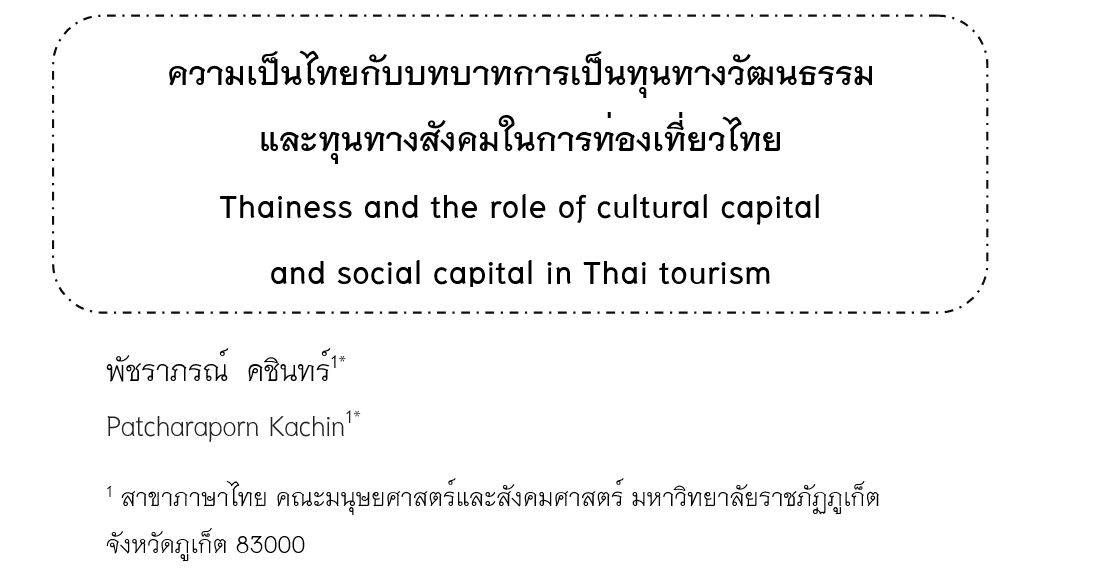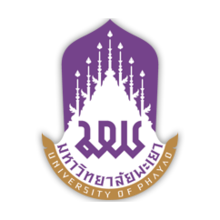Thainess and The Role of Cultural Capital and Social Capital in Thai Tourism
Keywords:
Thainess, Travel, Cultural capital, Social capitalAbstract
This article aims to present “Thainess” presented by the Tourism Authority of Thailand to promote tourism as a cultural capital through products and services with social capital to support. It is an academic article that aims to study both primary and secondary information with studying the origin and meaning of Thainess, analysis of tourism promotion policies and analyze the relationship between cultural capital and social capital to create “Thainess” has become a product to promote Thai tourism.
The results showed that The Tourism Authority of Thailand has tried to bring some elements of the cultural capital that exist in society to create. "Thainess" through the process of upholding the original value with the charm and uniqueness of Things are interpreted and designed in accordance with the behavior and needs of consumers until becoming a new value that is ready for tourists to choose to consume through historical aspects, beliefs lifestyle or science until they became "Representing Thainess" that is valuable and should be experienced for yourself The social capital serves to promote cultural capital to stand out and is known more widely. But if social capital does not interact as one. The achievements of tourism activities such as happiness or money may not be as desired. Therefore, if Thailand still relies on tourism income based on the meaning of Thainess Those involved need to pay attention. both the utilization of cultural capital appropriately and promote the network relationship of social capital to support each other until they can develop into a sustainable tourism based on the idea that the feeling that arises after traveling is not only pleasure or relaxation. But also has a meaning and has a valuable effect that is related to the feelings of Thai people.
References
กระทรวงการท่องเที่ยวและกีฬา. (2558). แผนยุทธศาสตร์การท่องเที่ยวไทย พ.ศ. 2558 – 2560. สืบค้น 20 ธันวาคม 2562, จาก https://www.mots.go.th/ewt_dl_link.php?nid=7114.
กิ่งแก้ว บัวเพชร. (2549). การมีส่วนร่วมในการจัดการการท่องเที่ยวเชิงนิเวศโดยชุมชน : กรณีศึกษาชุมชนคีรีวง อำเภอลานสกา จังหวัดนครศรีธรรมราช. โทรทัศน์. (วิทยานิพนธ์ปริญญามหาบัณฑิต). กรุงเทพฯ: จุฬาลงกรณ์มหาวิทยาลัย.
คริส เบเกอร์ และ ผาสุก พงษ์ไพจิตร. (2557). ประวัติศาสตร์ไทยร่วมสมัย. กรุงเทพฯ: มติชน.
ณัชช์นนท์ ทองแพง. (2560). ภาพตัวแทนความเป็นไทยผ่านสติ๊กเกอร์ไลน์. (วิทยานิพนธ์ ศิลปศาสตรมหาบัณฑิต บัณฑิตวิทยาลัย). กรุงเทพฯ: มหาวิทยาลัยธรรมศาสตร์.
ธงชัย วินิจจะกุล. (2547). “คำนำเสนอ” ใน นิธิเอียวศรีวงศ์. ชาติไทย, เมืองไทย, แบบเรียนและอนุเสาวรีย์. กรุงเทพฯ: มติชน.
นภาภรณ์ อินโน. (2559). “ตุ๊กตุ๊กไทยแลนด์” ได้เวลาแหวกขนบชุดประจำชาติ? โคมไฟจากหนังแกะลาย. วารสารอุตสาหกรรมสาร, 58(6), 23. สืบค้น 10 กุมภาพันธ์ 2565, จาก https://e-journal.dip.go.th/dip/images/ejournal/fd2eaa1aedd740f4b4e3234 6220a000d.pdf.
นุชเนตร จักรกลม. (2559). ผ้าพันคอลายเครื่องปั้นบ้านเชียง. วารสารอุตสาหกรรมสาร, 58(6), 12-27. สืบค้น 10 กุมภาพันธ์ 2565, จาก https://e-journal.dip.go.th/dip/images/ejournal/fd2eaa1aedd740f4b4e 32346220a000d.pdf.
เบญญาภา ศุภพานิชย์ และ อาแว มะแส. (2555). ทุนทางสังคมกับการจัดการการท่องเที่ยวเชิงอนุรักษ์: กรณีศึกษาตลาดคลองสวนร้อยปี อำเภอบางบ่อ จังหวัดสมุทรปราการ. วารสารวิจัยและพัฒนามหาวิทยาลัยราชภัฏเลย, 7(20), 41-52. สืบค้น 10 กุมภาพันธ์ 2565, จาก https://so05.tci-thaijo.org/index.php/researchjournal-lru/article/view/106904.
ประชา สุวรีรานนท์. (2554). ไทย ๆ อัตลักษณ์ไทย: จากไทยสู่ไทย ๆ. กรุงเทพฯ: ฟ้าเดียวกัน.
มิ่งสรรพ์ ขาวสะอาด. (2555). การท่องเที่ยวจากนโยบายสู่รากหญ้า (พิมพ์ครั้งที่ 2). กรุงเทพฯ: สำนักงานกองทุนสนับสนุนการวิจัย (สกว.).
เมญาพิมพ์ สมประสงค์. (2538). ความคิดเห็นของผู้รับสารที่มีต่อแนวคิดเรื่อง “ความเป็นไทย” ในภาพยนตร์โฆษณาที่เน้นความเป็นไทยจากสื่อโทรทัศน์. กรุงเทพฯ:จุฬาลงกรณ์มหาวิทยาลัย.
เมธาวี จำเนียร. (2564). อัตลักษณ์ผลิตภัณฑ์ชุมชนสู่การสร้างและสื่อสารแบรนด์กรณีศึกษา การแสดงรำโทนนกพิทิด. วารสารราชพฤกษ์, 19(2), 1-12. สืบค้น 10 กุมภาพันธ์ 2565, จาก https://so05.tci-thaijo.org/index.php/Ratchaphruekjournal/article/download/250722/171644.
ราชบัณฑิตยสถาน. (2556). พจนานุกรมฉบับราชบัณฑิตยสถาน พ.ศ. 2554 (พิมพ์ครั้งที่ 2). กรุงเทพฯ: นานมีบุ๊คส์พับลิเคชั่นส์.
รุ้งนภา ยรรยงเกษมสุข. (2557). มโนทัศน์ชนชั้นและทุนของ ปิ แอร์บร์ดิเออ. วารสารเศรษฐศาสตร์การเมืองบูรพา, 2(1), 29-44. สืบค้น 10 กุมภาพันธ์ 2565, จาก http://www.polsci-law.buu.ac.th/pegjournal/document/2-1/2.pdf.
วรา จันทร์มณี. (2561). บันทึกเรื่องราว ความทุกข์ของคนที่อยู่บ้านตัวเองไม่ได้. สืบค้น 10 ตุลาคม 2563, จาก https://www.facebook.com/ThebestofOzone/posts/1670758266347712.
วีระ อำพันสุข. (2551). ความเป็นไทย. กรุงเทพฯ: สำนักงานพระพุทธศาสนาแห่งชาติ.
วุฒิชัย กฤษณะประกรกิจ. (2556). ภาพตัวแทนของความเป็นไทย. สืบค้น 14 พฤศจิกายน 2563, จาก http://www.etatjournal.com/web/menu-read-web-etatjournal/menu-2013/menu-2013-apr-jun/514-22556-thai-portray.
สายชล สัตยานุรักษ์. (2550). ประวัติศาสตร์วิธีคิดเกี่ยวกับสังคมและวัฒนธรรมไทยของปัญญาชน พ.ศ.2435-2535. กรุงเทพฯ: สำนักงานกองทุนสนับสนุนการวิจัย.
สำนักนายกรัฐมนตรี, สำนักเลขาธิการคณะรัฐมนตรี. (2557). คำแถลงนโยบายของคณะรัฐมนตรี. กรุงเทพฯ: คณะรัฐมนตรีและพระราชกิจจานุเบกษา.
สินาด ตรีวรรณไชย. (2548). ทุนทางสังคม: ความหมายและความสำคัญ. สืบค้น 14 พฤศจิกายน 2563, จาก https://prachatai.com/journal/2005/01/2262.
อุษา ศิลป์เรืองวิไล. (2559). ความเชื่อมโยงระหว่างการสื่อสารเรื่องค่านิยมหลักของไทย 12 ประการกับวัฒนธรรมไทย และอัตลักษณ์ในทัศนะของวัยรุ่นไทยภายใต้กรอบแนวคิดบนพื้นฐานแนวคิดการใส่รหัสและถอดรหัส ของสจวร์ต ฮอลล์. วารสารวิชาการมหาวิทยาลัยอีสเทิรนเอเชีย, 6(3), 88-100.
MGR Online. (13 ตุลาคม 2558). “ตุ๊กตุ๊กไทยแลนด์” ได้เวลาแหวกขนบชุดประจำชาติ?. สืบค้น 18 พฤศจิกายน, จาก https://mgronline.com/live/detail/9580000114904.

Downloads
Published
How to Cite
Issue
Section
License
Copyright (c) 2022 Phayao University

This work is licensed under a Creative Commons Attribution-NonCommercial-NoDerivatives 4.0 International License.
ผู้นิพนธ์ต้องรับผิดชอบข้อความในบทนิพนธ์ของตน มหาวิทยาลัยพะเยาไม่จำเป็นต้องเห็นด้วยกับบทความที่ตีพิมพ์เสมอไป ผู้สนใจสามารถคัดลอก และนำไปใช้ได้ แต่จะต้องขออนุมัติเจ้าของ และได้รับการอนุมัติเป็นลายลักษณ์อักษรก่อน พร้อมกับมีการอ้างอิงและกล่าวคำขอบคุณให้ถูกต้องด้วย
The authors are themselves responsible for their contents. Signed articles may not always reflect the opinion of University of Phayao. The articles can be reproduced and reprinted, provided that permission is given by the authors and acknowledgement must be given.







